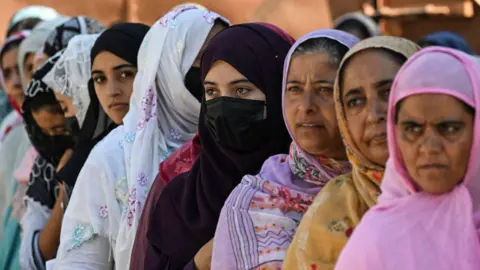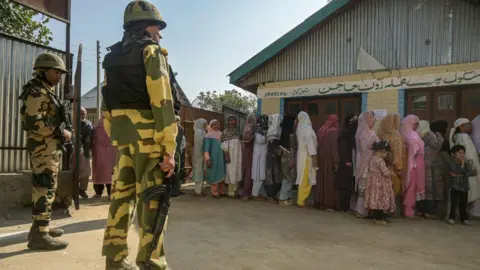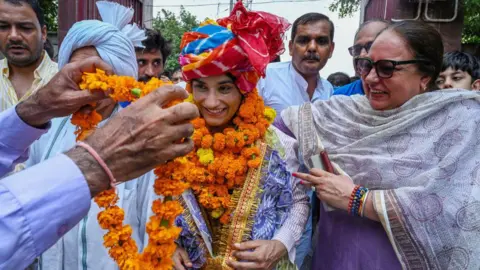Test for Modi’s BJP as vote count begins in Kashmir and Haryana
 Getty Images
Getty ImagesEarly trends show that an alliance of opposition parties is leading as votes are being counted after the first assembly election in Indian-administered Kashmir in a decade.
This was also the first assembly election to be held since the federal government revoked the region’s autonomy and changed the former state into a federally governed territory of Jammu and Kashmir in 2019.
Votes are also being counted in the northern state of Haryana, where Prime Minister Narendra Modi’s Bharatiya Janata Party (BJP) is currently ahead by a few seats against the main opposition Congress party.
These were the first state polls to be held in India since the general election, which returned the BJP to power with a reduced majority.
Exit polls have given an edge to opposition parties, including the Congress, in both Jammu and Kashmir and Haryana. But analysts warn these polls, released by various news agencies, have often been wrong in the past.
Both states have 90 assembly seats and a party or coalition that crosses the halfway mark can form the government.
According to votes counted till now, a coalition of the Congress and National Conference (NC) is ahead in around 40 seats in Jammu and Kashmir, while the BJP is leading in 22.
In Haryana, the Congress and BJP are currently in a neck-and-neck fight.
These numbers could change as more votes are counted.
The three-phase elections in Jammu and Kashmir saw top leaders from the BJP and Congress make several promises, including the restoration of full statehood.
Many voters told the BBC that they hoped that the election would give them a chance to voice their concerns after having no local representatives for years.
However, many say they are sceptical about how much influence the elected government will have, since the chief minister will have to get the federally appointed Lieutenant Governor’s approval on major decisions.
 Getty Images
Getty ImagesAfter the last election in 2014, the BJP had formed a government with the regional Peoples Democratic Party (PDP). But they parted ways in June 2018 over political and ideological differences amid rising violence in the Kashmir valley. Since then, Delhi has governed the region.
The elections in 2024 were closely watched as federal officials held them up as a proof of normalcy in a region facing militancy for decades.
The region has witnessed a violent insurgency against Indian rule for more than three decades, resulting in thousands of deaths.
India blames Pakistan for fomenting the violence, a charge its neighbour denies. The countries have fought two wars over Kashmir, which both claim in full but administer only in parts.
For the first time in decades, several separatists – who advocate for Kashmir’s independence from India – have taken part in the elections. Exit polls had suggested a hung assembly, so smaller players and regional parties might play a crucial role in government formation.
These polls also suggested that the BJP could perform well in Jammu, while regional parties such as the PDP and NC might play a crucial role in the Kashmir valley.
 Getty Images
Getty ImagesIn Haryana state, the governing BJP faced the challenge of anti-incumbency after a decade of being in power.
Exit polls have given the Congress a clear majority in the state, though trends till now indicate a closer fight.
The Congress’s prospects were also buoyed by anger over controversial federal farm laws – now withdrawn – and a short-term army recruitment scheme brought by the BJP.
The farm laws had sparked months of protests from farmers in Haryana and neighbouring states as protesters feared they would allow the entry of private players into agriculture.
The short-term army recruitment scheme, Agniveer, is a contentious issue in the state, which contributes a significant number of soldiers to the Indian army, especially at a time when India grapples with a jobs crisis.








